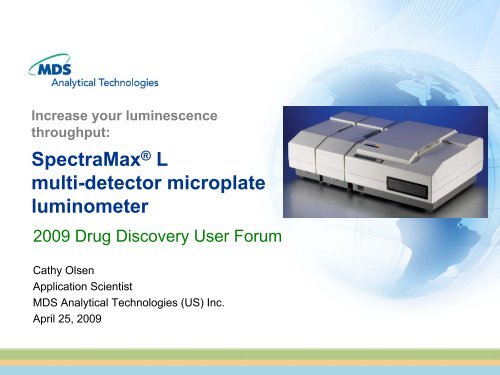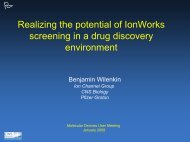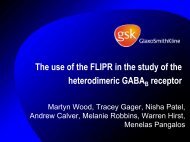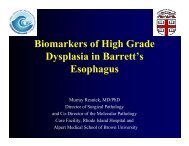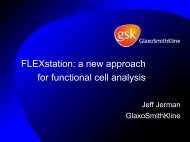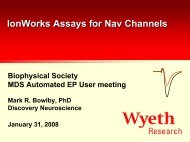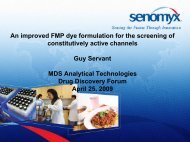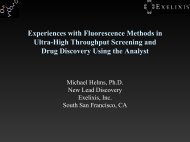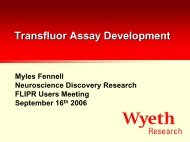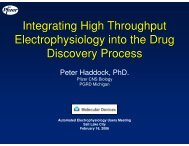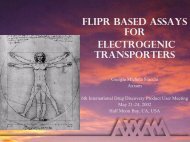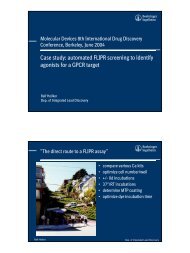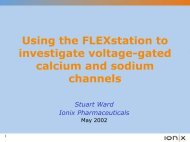SpectraMax® L multi-detector microplate luminometer - Molecular ...
SpectraMax® L multi-detector microplate luminometer - Molecular ...
SpectraMax® L multi-detector microplate luminometer - Molecular ...
Create successful ePaper yourself
Turn your PDF publications into a flip-book with our unique Google optimized e-Paper software.
Increase your luminescence<br />
throughput:<br />
SpectraMax ® L<br />
<strong>multi</strong>-<strong>detector</strong> <strong>microplate</strong><br />
<strong>luminometer</strong><br />
2009 Drug Discovery User Forum<br />
Cathy Olsen<br />
Application Scientist<br />
MDS Analytical Technologies (US) Inc.<br />
April 25, 2009
Agenda<br />
• Introducing the SpectraMax ® L <strong>microplate</strong> <strong>luminometer</strong><br />
o Multi-<strong>detector</strong> options<br />
o Features<br />
• Luminescent G-protein coupled receptor assays with aequorin<br />
o Features & advantages of aequorin GPCR assays<br />
o Performance on SpectraMax L <strong>microplate</strong> <strong>luminometer</strong><br />
o Scale up to FLIPR TETRA® system with aequorin option<br />
2
Introducing the SpectraMax ® L <strong>luminometer</strong><br />
• PMTs are optimized for typical wavelengths of luminescent emission<br />
• Ultra-fast photon counting technology<br />
o Amplifies PMT signal with fast pulse amplifier<br />
o Reduced noise<br />
• Higher signal-to-noise ratio<br />
• Low crosstalk<br />
• MaxRange for 9 orders of<br />
magnitude<br />
o Simultaneous analog and<br />
photon counting capability<br />
o No need to dilute bright samples<br />
o Excellent sensitivity for dim<br />
samples<br />
3
How luminescence is detected<br />
• Photo<strong>multi</strong>plier tube (PMT) converts incoming photons into electrons<br />
• Incoming photon strikes photocathode → generates electron<br />
• Electron flows through a series of electron <strong>multi</strong>pliers (dynodes) to the anode<br />
• Current flowing from anode ∝ number of photons at the photocathode<br />
• Amount of amplification a PMT can produce depends on (a) number of<br />
dynodes and (b) voltage applied to it<br />
4<br />
Source: http://micro.magnet.fsu.edu/primer/digitalimaging/concepts/photo<strong>multi</strong>pliers.html
SpectraMax ® L <strong>luminometer</strong>: Four PMT settings<br />
• Analog Only: Ideal for very bright signals above 1.6 x 10 7 RLU (low PMT voltage)<br />
• Photon Counting: Ideal for very dim and medium signals below 25 x 10 6 RLU (digital)<br />
• AutoRange: Extends range of Photon Counting mode by adding Analog (high PMT<br />
voltage)<br />
• MaxRange: Combines AutoRange and Analog Only modes<br />
o Captures entire dynamic range<br />
o 10 to 10 9 RLU<br />
AutoRange<br />
MaxRange<br />
5
PMT calibration<br />
• Automatic PMT calibration<br />
o Uses internal light-emitting diodes (LEDs)<br />
• Manual PMT calibration<br />
o Uses 4 wells containing actual assay material<br />
• Manual Set option<br />
o Manually enter calibration factors for each PMT<br />
6<br />
Results of PMT calibration using internal LEDs
SpectraMax ® L <strong>luminometer</strong> - configurable<br />
• With injectors → flash luminescence<br />
• Without injectors → glow luminescence<br />
• Configurations to meet every user’s<br />
needs<br />
o Single channel (PMT)<br />
• 0 or 2 injectors<br />
o 2-channel<br />
• 0, 2, or 4 injectors<br />
o 6-channel (PMT)<br />
• 0 or 12 injectors<br />
• Upgradeable<br />
7
Higher-throughput luminescence assays<br />
• Example: typical dual-luciferase assay<br />
• 2 injections + 2 reads = 25 seconds per well<br />
Number of PMTs/injector pairs 1 2 6<br />
Time to read a 96-well plate 40 min 20 min 6.7 min<br />
Plates read in 8 hours 12 24 72<br />
StakMax ® plate handling system<br />
enables automated reading of up<br />
to 50 plates.<br />
8<br />
SpectraMax ® L <strong>luminometer</strong> + StakMax plate handling system
AutoWash function<br />
Upon instrument shutdown:<br />
• Injectors reverse, returning reagents to bottles<br />
o Saves reagents, money<br />
• Injectors are automatically washed<br />
• Prevents precipitation from clogging injector lines<br />
o Fewer maintenance worries<br />
9
SoftMax ® Pro software<br />
• Data acquisition, analysis, graphing<br />
• Supports MDS AT <strong>microplate</strong> readers<br />
• Includes >120 pre-configured protocols<br />
o Optimal reader settings for each assay<br />
o Assay-specific data analysis<br />
Need to show GLP/GMP compliance with FDA 21 CFR Part 11 requirements<br />
• SoftMax Pro GxP provides FDA 21 CFR Part 11 compliance tools<br />
o Electronic signature support for verification, authorization, and approval<br />
o Audit Trail to track and record user and administrator actions<br />
o And much more…<br />
• Optional software validation tools<br />
• Visit http://www.moleculardevices.com/pages/software/softmax.html<br />
10
Applications for SpectraMax ® L system<br />
• Aequorin GPCR assays<br />
• Luciferase reporter assays, including DLR (Promega)<br />
o Flash & glow versions<br />
• Bioluminescence resonance energy transfer (BRET)<br />
o BRET1 & BRET2 options<br />
• Cell viability and toxicity assays<br />
• Mycoplasma monitoring<br />
• ATP detection<br />
• Luminescent ELISAs<br />
• Acridinium ester<br />
• And many, many more…<br />
11
Luminescence protocols in SoftMax ® Pro software<br />
• Aequorin GPCR<br />
• Dual-Luciferase Reporter (Promega)<br />
• Dual-Glo Luciferase (Promega)<br />
• Ready-To-Glow Secreted Luciferase (Clontech)<br />
• Luminescent ELISA<br />
• CellTiter-Glo (Promega)<br />
• MycoAlert (Lonza)<br />
• ATP assay<br />
• dsDNA assay<br />
12
Moving on…<br />
• Introducing the SpectraMax ® L <strong>microplate</strong> <strong>luminometer</strong><br />
o Multi-<strong>detector</strong> options<br />
o Features<br />
• Luminescent G-protein coupled receptor assays with aequorin<br />
o Features & advantages of aequorin GPCR assays<br />
o Performance on SpectraMax L <strong>microplate</strong> <strong>luminometer</strong><br />
o Scale up to FLIPR TETRA® system with aequorin option<br />
13
Aequorin overview<br />
• Photoprotein originating from the jellyfish Aequorea victoria<br />
• Aequorin binds Ca ++ → oxidizes coelenterazine → CO 2 + light<br />
• Aequorin is used to detect GPCR signaling via Ca ++ in cells<br />
• Reaction is very fast (10-30 seconds)<br />
• Assay is read on <strong>luminometer</strong> equipped with injector or pipettor<br />
GPCR<br />
Agonist<br />
α β γ<br />
PLC<br />
Apoaequorin<br />
Coelenterazine<br />
IPs<br />
Aequorin<br />
+<br />
Ca ++<br />
14<br />
Flash lumi
Advantages of aequorin assays<br />
• Luminescent signal reduces problems of auto-fluorescence,<br />
compound interference<br />
• Targeting photoprotein expression to specific parts of cell allows<br />
more target-specific signal resolution<br />
• Wide dynamic range (10 -7 to 10 -4 M) covers physiological Ca ++<br />
signals<br />
• Low calcium buffering effect compared to fluorescent reagents<br />
• Expression is non-toxic<br />
• Reduced cost (10x less) compared to fluorescence or luciferase<br />
assays<br />
• Cells can be delivered in suspension*<br />
o Reduces cost<br />
15<br />
o Increases throughput *These assay methods are also described in the literature, e.g. in Boie et al., Eur. J.<br />
Pharmacol., 340(2-3):227-241 (1997), and in United States Patent 6,872,538 and<br />
European Patent 1,145,002. Users interested in the patented methods may wish to<br />
consult legal counsel in evaluating these patents.
Disadvantages<br />
• Requires reconstitution with coelenterazine<br />
o Similar to dye loading, but from 4 hours to overnight<br />
• Aequorin consumption<br />
o No long-term recording or <strong>multi</strong>ple additions<br />
• Possible EC 50 /IC 50 shift compared to other methods<br />
• Not all GPCR assays are amenable to aequorin<br />
o GPCRs that do not signal via Ca ++<br />
16
Aequorin assays on SpectraMax ® L system<br />
• Preconfigured protocol in SoftMax ® Pro software<br />
• Automatic data reduction and analysis<br />
• 4-parameter curve fit<br />
17
AequoZen frozen cells (PerkinElmer)<br />
• Cryopreserved, γ-irradiated cell lines<br />
• Good for single use, cannot be propagated<br />
• CHO-K1 cell lines expressing GPCR<br />
o Histamine H 1 (stronger response)<br />
o Muscarinic M 5 (weaker response)<br />
18
AequoZen M 5 cell line: agonists<br />
Concentration-response curves from SpectraMax ® L system<br />
EC 50 from product insert = 16.2 nM<br />
EC 50 from product insert = 25.7 nM<br />
19
AequoZen M 5 cells - antagonist<br />
Concentration-response curves from SpectraMax ® L system<br />
20<br />
IC 50 from product insert = 3.2 nM
AequoZen H 1 cell line - agonists<br />
Concentration-response curves from SpectraMax ® L system<br />
EC 50 from product insert = 4.6 nM<br />
EC 50 from product insert = 4.8 uM<br />
21
AequoZen H 1 cell line - antagonists<br />
Concentration-response curves from SpectraMax ® L system<br />
EC 50 from product insert = 4.9 nM<br />
EC 50 from product insert = 2.8 uM<br />
22
SpectraMax ® L & FLIPR TETRA® systems<br />
• SpectraMax L provides low to medium throughput for luminescent assays<br />
o Assay development<br />
o Initial screens<br />
o StakMax ® plate handler for increased automation<br />
o Aequorin results similar to FLIPR TETRA<br />
• FLIPR TETRA provides high-throughput capability<br />
o Aequorin assays in suspension or adherent modes<br />
o 1536-well assays<br />
23
Conclusions<br />
• SpectraMax ® L system is highly configurable & upgradeable<br />
• Increases throughput for luminescence assays<br />
o Especially when paired with StakMax ® plate handling system<br />
• Enables a vast array of luminescent applications<br />
• SoftMax ® Pro software with preset protocols<br />
• Data quality comparable to FLIPR TETRA®<br />
o SpectraMax L system for low-medium throughput<br />
o FLIPR TETRA for high throughput<br />
24
Acknowledgments<br />
• Carole Crittenden<br />
• Michael Su<br />
• Wilson Toy<br />
25
Thanks for your attention<br />
• For more information online:<br />
http://www.moleculardevices.com/home.html<br />
• Poster #P8007: Session P8 Automation and Detection Platforms<br />
• SpectraMax L demos will be presented in the MDS AT booth<br />
26


